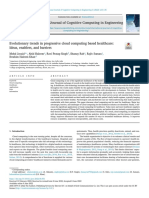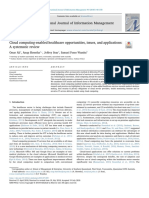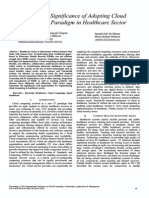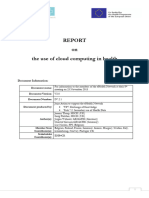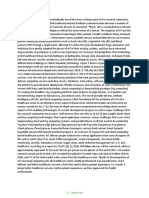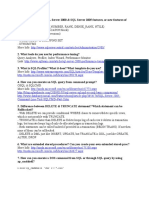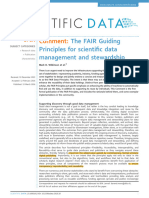Global Journal of Health Science; Vol. 9, No.
6; 2017
ISSN 1916-9736 E-ISSN 1916-9744
Published by Canadian Center of Science and Education
Applications of Cloud Computing in Health Systems
Hamid Moghaddasi1 & Alireza Tabatabaei Tabrizi2
1
Associate Professor in Health Information Management and Medical Informatics, Department of Health
Information Technology and Management, Faculty of Paramedical Sciences, Shahid Beheshti University of
Medical Science, Tehran, Iran
2
PhD Candidate in Medical Informatics, Department of Health Information Technology and Management,
Faculty of Paramedical Sciences, Shahid Beheshti University of Medical Science, Tehran, Iran
Correspondence: Alireza Tabatabaei Tabrizi, Department of Health Information Technology and Management,
paramedical school, , Shahid Beheshti University of Medical Science, Darband Street, Ghods Square (Tajrish),
Tehran, Iran. Tel: 98-212-243-9982. E-mail: A.tabatabaei@sbmu.ac.ir
Received: August 21, 2016 Accepted: October 8, 2016 Online Published: October 28, 2016
doi:10.5539/gjhs.v9n6p33 URL: http://dx.doi.org/10.5539/gjhs.v9n6p33
Abstract
Introduction: Equitable access to health services is one of the health justice criteria. E-health can sometimes be
helpful in this regard. This study is aimed to find the use of cloud computing services across health system.
Method: In the present review article, numerous research papers from different resources, such as MEDLINE,
IEEE and Science direct, were studied. Based on the subject, 210 studies were found. After quality analysis of the
papers, 78 studies were selected, from which 53 articles were directly related to the applications of cloud
computing in health system.
Findings: Cloud computing services are widely used in various industries. Therefore, health system takes
advantage of the services. Findings indicate that, the applications of cloud computing in health system, including
telemedicine, medical imaging, public and personal health, clinical and hospital information systems, medical
decision support system, care, secondary use of health data, serve as different types of specialized software used to
analyze gene sequences and archive huge biological data. Generally cloud computing services are available in two
sectors in any health system as follows: E-health services and Bioinformatics.
Conclusion: Facilitated access to the E-health services and big data in health systems are the main features of
exploiting cloud computing services in health systems. Using cloud computing in health systems not only makes
health services more affordable, but also helps nations to achieve health equity.
Keywords: cloud computing, E-health, Cloud E-health
1. Introduction
Justice plays significant role in health systems and one major popular expectation from sovereign governments is
to move toward equity, which according to definition of WHO, means closing the gap between socially,
economically, demographically, or geographically categorized groups in term of access to resources, opportunities,
and facilities. In the context of healthcare, equity is often defined with impartial access to health and hygiene
resources and fairness of health determinants (World Health Organization, 2016). Some studies suggest that
investments in ICT in health domain may reduce disparities in the process of care (Lee, 2015). On the other hand,
others believe that ICT holds the potential to improving the quality, safety and equity of health care, but it also has
the potential to unintentionally increase disparities in health and health care (Kieschnick & Raymond, 2011). As
we know, most ICT services in health are delivered as E-health service. E-health is the response of modern
technology to the health inequity, but when poorly implemented, has a potential for widening the access gap
between wealthy people with great access to computers and networks or people who can use these technologies
effectively and other people who fall in neither of these categories. This means that a major challenge ahead of
E-health is to cross the digital divide between gender, social, geographical, age groups and reach out to people who
need the E-health services the most (Eysenbach, 2001; Oh, Rizo, Enkin, & Jadad, 2005 ) Meanwhile, the growing
demands for up-to-date healthcare services, which is mainly due to increasing health-awareness of populations,
and the often unsuccessful struggle of regional and national administrations to satisfy this level of demand can be
alleviated by e-health solutions, but the lack of infrastructure required for such solutions limit their short and
33
�gjhs.ccsenet.org Global Journal of Health Science Vol. 9, No. 6; 2017
medium term potential. For example, Medical Body Area Network (MBAN), which is a good solution for
real-time health monitoring, requires massive amount of scalable ICT infrastructure for data storage and real time
processing of information pertaining to millions of patients, which makes it unaffordable for most countries (Lu,
Ranjan, & Strazdins, 2014). It is common to describe such massive volumes of complex data with the term “big
data”. This term is also closely associated with the methods required for capturing, storing, processing, and
managing such massive quantities of data. In health system, the major sources of health related to big data could be
categorized as: (a) payer–provider big data consisting of electronic health records, insurance records, pharmacy
prescriptions, patient feedback, responses and (b) genomics-driven big data comprising genotyping and
sequencing data (Abbas, Bilal, Zhang, & Khana, 2014; Barker & Stuart Ward, 2013). One of the ICT innovations
which could solve the health inequity and health big data problems is cloud computing model. The Cloud
computing is not a new concept; it can date back to 1961 at the MIT Centennial when John McCarthy opined that
“computation may someday be organized as a public utility” (Dai, Gao, Guo, Xiao, & Zhang, 2012). Cloud
computing is a conceptual model about computer services including a set of servers with remote access to share
resources like storages, networks, applications and platform as services. This model prepares opportunities to
centralize data storage and real time access to resources and services (Mell & Grance, 2011; Wikipedia, 2016). The
cloud computing model is composed of five essential characteristics, four service models, and four deployment
models. The five essential characteristics are: On-demand self-service, broad network access, resource pooling,
rapid elasticity and measured service. Three models as service layers of cloud are: Data as a Service (DaaS),
Software as a Service (SaaS), Platform as a Service (PaaS) and Infrastructure as a Service (IaaS). And finally four
deployment models of cloud are: private cloud, community cloud, public cloud and hybrid cloud. The definition of
cloud computing models is presented by national institute of standard and technology (NIST) in a study entitled:
“NIST definition of cloud computing” (Mell & Grance, 2011) and another study entitled: “cloud computing: A
Perspective study” (Lizhe, Kunze, & Tao, 2008). Cloud computing uses service oriented architecture (SOA) and
virtualization technics to be a powerful model. According to cloud computing adaption survey in 2009 in USA and
Canada, 32% of healthcare organization use the cloud computing and have taken advantage of its benefits
(Mimecast survey, 2010). One method that has successfully tackled the above said challenges is the cloud
computing. This technology is expected to make significant changes in the future of electronic health services, and
some even predict that by 2020, around 80% of the current online services will be running on the cloud (Sanjay,
Ahuja, & Zambrano, 2012). So it seems that health system will take advantage of cloud benefits like other
industries. This study is conducted to find out the applications of cloud computing in health system.
2. Method
This review study was intended to present some important concepts about cloud computing services. As such the
study discussed the findings of some studies using different scientifically valid publication databases like the
MEDLINE, IEEE and Science direct. Based on the subject of the study, 210 studies were found. After quality
analysis of these studies, 78 articles were selected of which 53 articles were directly related to the applications of
cloud computing in health system. To investigate the quality of the articles in possession, they were evaluated in
terms of title, abstract, introduction, research method, results, discussion and references. The scholarly articles
were published from 2008 to 2016 were obtained through a comprehensive and detailed review.
3. Findings
According to previous studies, the cloud computing layered model was applied in different aspects of health
system. One of the major aspects using cloud computing in health systems is E-health services. The critical
importance of applying cloud computing in E-health is to the point that the term “E-health Cloud” has been
generated. The capabilities of cloud can alleviate some restriction induced by ICT infrastructure on realization of
broader E-health services (Kuo, 2011). Electronic health services are provided in many areas some of which
include: Health information system, telemedicine services, personal health record, electronic medical record and
electronic health record (Comyn, 2009). The service layer model of E-health Cloud includes:
(1) Data as a Service: presents data (e.g., databases)
(2) Software as a Service: provides software in cloud (e.g., clinical Information systems) where consumers such as
healthcare providers get access to the software in the cloud.
(3) Platform as a Service: extends the basic infrastructure with High-level integrated environment to design, build,
test, deploy and update online healthcare applications.
(4) Infrastructure as a Service: presents physical processing and storage resources.
Broad spectrum of recipients of services from cloud computing in health systems could be: patients, healthcare
34
�gjhs.ccsenet.org Global Journal of Health Science Vol. 9, No. 6; 2017
organizations, insurance companies, researchers, epidemiologists, etc. (Dai et al., 2012; Kuo, 2011). In the
following sections, some of the applications of cloud computing in health systems are presented.
3.1 Healthcare information system as a Service
Apart from the benefits of healthcare information system for health care organizations, software and hardware cost,
complexity and inflexibility issues of healthcare system have raised a lot. So, the development of low cost
technology is essential to reduce the charges. Cloud computing helps to develop and solve various healthcare
issues, including the costs. Cloud computing brings significant benefits to healthcare information systems. It can
solve various healthcare issues, such as data storage, data transmission, high setup cost, software maintenance and
optimizing resources (Masrom & Rahimli, 2014). For example, in 2012, Yoo et al. managed to combine
virtualization technology, a virtual desktop infrastructure, and 400 virtual machines to a construct a cloud within
Bundang Hospital of Seoul National University (Korea) to allow managed but easy and pervasive access to
hospital information from mobile devices throughout the hospital (Yoo, Kim, Baek, Suh, Chung, and Hwang,
2012).Another example is a work carried out in 2011 by Yao et al. The community cloud-based medical service
delivery framework (CMSDF) developed in that work allowed resource exchange between a large general hospital
and its affiliated healthcare institutions. They also tested a prototype CMSDF, where a cloud-based virtual desktop
infrastructure (VDI) of a large hospital was allowed to share its medical software (as SaaS) with its affiliated
healthcare institutions (Yao, Han, Ma, Xue, Chen, & Li, 2014).
3.2 Telemedicine as a Service
Nowadays, cloud computing is used as ICT infrastructure for telemedicine projects. Telemedicine and cloud
computing allows health services to be provided with a lower-cost and thus greater availability. In a study in India,
researchers studied the implementation of a telemedicine project and reported a number of bugs in the form of low
bandwidth or high cost. They developed a cloud-based solution to address these issues (Matlani & Londhe, 2013).
In a project in Australia concerning cloud-based telemedicine, the cloud was combined with multiple concepts
such as E-appointment, E- consulting, Telemedicine, and E-Prescription to enable patients to use the internet for
maintaining remote connection with their physicians and discussing their health-related problems. The resulting
system allowed the physician to easily access the patient’s medical history, files, test results, etc. This system also
provided the physician with data regarding the patient’s physiological status through body sensor networks. In that
work, telemedicine design was implemented as a hybrid system composed of various communication techniques
and hardware including web camera for video feed, Microsoft Expression Encoder 4, and also Windows Azure
virtual machine as the server, since it allows adequate video/ audio processing through live streaming media server
(Lu, Ranjan, & Strazdins, 2014).
3.3 Personal Health Record (PHR) as a Service
Another high potential application for the cloud in E-health is to manage access to personal health records (PHR)
and Electronic Health Records (EHR). The MyPHRmachines system developed in the Eindhoven University of
technology is a combination PHR system and cloud technology, which allows users to access raw PHR database
via specialized software and share and analyze the PHR data made available. In the architecture of this system,
data and software components are separate but software sharing measures allowing joint use of health-related data
are predicted. Another advantage of this architecture is its ability to delegate access to different users with more
flexibility but also adequate security. For example, patients using MyPHRMachines can share selective health
information with a physician without needing to worry about improper storage (and thus misuse) by physician or
any third party, as shared data cannot be stored beyond a time limit, and unshared data is securely out of reach of
third party software components, services, and specialists (Van Gorp & Comuzzi, 2012). Another cloud-based
platform allowing convenient PHR management is the Microsoft HealthVault. This architecture allows patients to
store, manage, and share their PHR by providing them with convenient means of importing their health data from
a wide range of medical devices into the HealthVault without any need to intermediary tools and software. Once
imported, medical data can be easily monitored, managed, and shared through a GUI. This program also possesses
advanced sharing features allowing different level of control over shared data, multi-profile sharing, and sharing
with designated health organizations, devices, or software applications, all under supervision of data owner.
HealthVault can also be embedded into or developed with desktop and mobile applications, as it is based on
standard sharing protocols like SOAP, CCR/CCD and XML and is equipped with programmer APIs (Sunyaev,
Chornyi, Mauro, & Kremar, 2010).
3.4 Clinical Decision Support System (CDSS) as a Service
E-health services and cloud technology can also be used to augment Clinical Decision Support system (CDSS).
35
�gjhs.ccsenet.org Global Journal of Health Science Vol. 9, No. 6; 2017
For example, Brayan et al. developed and tested a cloud-based CDSS on a new information management and
sharing framework for the repository proposed by Clinical Decision Support Consortium (CDSC), (Middleton,
2009). This repository consists of data concerning hypertension, diabetes, and coronary artery diseases and is
based on a community cloud hosted by Partners HealthCare. In that architecture, the cloud hosts a CDSS rule
engine that stores a limited data set pertaining to primary care patients and can announce preventive care
notification (based on this limited data set) to clinician and end users. That study provided an adequately
implementable remote and asynchronous cloud-based decision support system. However, the remaining
challenges ahead of actual implementation of cloud-based CDSS, which span over different topics such as
governance, semantic interoperability, and usability, need much further work by both biomedical informatics and
computer science experts. But overall, one major contribution of that study was the evidence supporting the
feasibility of cloud-based decision support systems and their potential applicability in improving these systems for
different groups of health care providers (Dixona, Simonaitis, Goldberge, Paterno, Schaeffer, & Hongsermeierf,
2013).
3.5 Biological Software as a Service
Some biologic subject areas such as genomics and proteomics have already been overwhelmed with big data.
Wining DNA sequencing throughput, in the race between computer speed and DNA sequencing is the evidence.
Nowadays cloud computing model solves the problem of big data in biological software. As an example of big data
in biology, we can mention the Gen-Bank (NCBI, 2016). The size of data in this repository is over 150 billion
nucleotide bases in more than 162 million sequences in 2013 (Schatz, Langmead & Salzberg, 2010). Using a cloud
computing to solve this problem is called “bioinformatics cloud” in some studies. This cloud model delivers a
large variety of services from data storage, data acquisition, to data analysis, which in general fall into four
categories which are known as DaaS, SaaS, PaaS, IaaS (Dai et al., 2012). Operational samples of each layer are
presented in Table1, Including services AWS Public Datasets (Amazon organization, 2016), Cloud Aligner
(Sourceforge, 2016), Eoulsan (Jourdren, Bernard, Dillies, & Le Crom, 2016), CloVR (National Human Research
Institute, 2016).
Table 1. Examples of services in bioinformatics clouds based on each layer
Layer DaaS SaaS PaaS IaaS
Service AWS Public Datasets Cloud Aligner Eoulsan CloVR
Description Cloud-based archives of Fast and full-featured Cloud-based platform A portable virtual
GenBank, Ensembl, MapReduce based tool for high throughput machine for
1000 Genomes, Model for sequence mapping. sequencing analyses. automated sequence
Organism Encyclopedia analysis using cloud
of DNA Elements, computing.
Unigene, Influenza
Virus, etc.
Another example of using cloud in bioinformatics is Azure Blast. Another potential for cloud-based development
is in optimization of the BLAST life science algorithm and other data intensive scientific tools in the field of
bioinformatics. In case of the BLAST algorithm, pairwise alignments can be carried out independently so
parallelization of algorithm is not difficult but rather unaffordable because of large-scale of resources required.
With the cloud technology however, there is a better chance for achieving a more readily available large-scale
alignment search. One example of this approach is the Azure Blast, which can combine the computing power of
thousands of Azure instances running on different machines (Lu, Jackson, & Barga, 2010).
4. Discussion
Based on a study about the translational biomedical informatics in the cloud, the applications are categorized in 4
segments as follows: Bioinformatics (molecules and cells); Imaging informatics (tissues and organs); Clinical
informatics (individuals); and Public health informatics (populations) (Chen, Qian, Yan, & Shen, 2013).In another
study, the application of cloud in the health scope is divided into six categories referred to as: Telemedicine/Tele
consultation; Medical imaging; Public health and Patients’ self-management; Hospital management/Clinical
information systems; Therapy; and Secondary use of data (Griebel, Prokosch, Kopcke, Toddenroth, & Christoph,
2015). Finally, the extent of use of cloud computing in the health system can be classified in two subject areas
36
�gjhs.ccsenet.org Global Journal of Health Science Vol. 9, No. 6; 2017
which include E-health services, and Bioinformatics services. Table2 shows the number of found articles from the
introduced resources.
Table 2. The number of studies categorized based on found applications
Application scope Number of studies
1 E-health services 38
2 Bioinformatics services 15
Nowadays, most software projects of the world which are in the form of Total Systems are implemented as a Web
application (Tabatabaei Tabrizi & Sadighi Moshkenani, 2008). In the same way, the countless opportunities
provided by the cloud technology for healthcare systems include provision of pay-as-you-go pricing models
allowing reduced need for initial capital investments in the ICT infrastructure, better utilization of ICT resources
and thus better quality of healthcare services, and provision of efficient and scalable tools for sharing and
management of massive volumes of medical information such as EHR and medical files distributed across
E-health systems (Lu, Ranjan, & Strazdins, 2014). Addressing the challenges of a modern e-health system (e.g.
scalability, agility, cost effectiveness, and ubiquitous availability of medical information) requires extensive
collaboration among multiple domains of healthcare and informatics, which according to many experts, can be
achieved through innovative cloud-based solutions, and thereby bring about significant changes in the quality and
availability of health care services, and speed, universality and ease of health care research (Abbas et al., 2014;
Kuo, 2011 ). However, the cloud computing services face challenges like data security management.
5. Conclusion
Obviously, the applications of cloud computing in health systems are not limited to the examples which were
mentioned in this study. Using cloud computing in any kind of E-health services will be efficacious when we need
qualitative parameters including On-demand self-service, broad network access, ICT resource pooling, rapid
elasticity in ICT and measured services. Various applications are developed based on the nature of the service
which provides sharing resources in four levels (DaaS, SaaS, PaaS and IaaS). The point is that, the use of cloud
computing in health systems not only makes health services more affordable, but also helps nations to achieve
health equity.
Competing Interests Statement
The authors declare that there is no conflict of interests regarding the publication of this paper.
References
Amazon Organization. (2016). AWS Public Data set. Retrieved from: www.aws.amazon.com/publicdatasets.
Abbas, A., Bilal, K., Zhang, L. & Khana, S. U. (2014). A cloud based health insurance plan recommendation
system: A user centered approach. Journal of Future Generation Computer Systems, 8(2), 1-10.
http://dx.doi.org/10.1016/j.future.2014.08.010
Barker, A., & Stuart Ward, J. (2013). Undefined By Data: A Survey of Big Data Definitions. School of Computer
Science University of St Andrews, UK. Retrieved from: https://arxiv.org/abs/1309.5821v1.
Chen, J., Qian, F., Yan, W. & Shen, B. (2013). Review Article: Translational Biomedical Informatics in the Cloud:
Present and Future. Hindawi Publishing Corporation BioMed Research International, 2013. Retrieved from:
http://dx.doi.org/10.1155/2013/658925
Comyn, G. (2009). eHealth: a solution for European healthcare systems. eHealth in Europe. Retrieved from:
ec.europa.eu/information_society/newsroom.
Dai, L., Gao, X., Guo, Y., Xiao, J. & Zhang, Z. (2012). Bioinformatics clouds for big data manipulation.
BiologyDirect, 1-7. http://dx.doi.org/10.1186/1745-6150-7-43
Dixona, B E., Simonaitis, L., Goldberge, H. S., Paterno, M. D., Schaeffer, M., & Hongsermeierf, T. (2013). A pilot
study of distributed knowledge management and clinical decision support in the cloud. Artificial Intelligence
in Medicine, 59(4), 45-53. http://dx.doi.org/10.1016/j.artmed.2013.03.004
Eysenbach, G. (2001). What is e-health. Journal of Medical Internet Research, 3(2).
http://dx.doi.org/10.2196/jmir.3.2.e20
37
�gjhs.ccsenet.org Global Journal of Health Science Vol. 9, No. 6; 2017
Griebel, L., Prokosch, H., Kopcke, F., Toddenroth, D., & Christoph, J. (2015). A scoping review of cloud
computing in healthcare. BMC Medical Informatics and Decision Making, 15(17), 1-16.
http://dx.doi.org/10.1186/s12911-015-0145-7
Jourdren, L., Bernard, M., Dillies, M., & Le Crom, S. (2016). Eoulsan: A Cloud Computing-Based Framework
Facilitating High Throughput Sequencing Analyses. Retrieved from http://transcriptome.ens.fr/eoulsan.
Kieschnick, T., & Raymond, B. (2011). Can Health IT Promote Health Equity and Patient-Centered Care? Kaiser
Permanente, Institute for Health Policy. Jointly sponsored by the Agency for Healthcare Research and Quality,
AMIA.
Kuo, A. M. (2011). Opportunities and Challenges of Cloud Computing to Improve Health Care Services. Journal
of Medical Internet Research, 13(3). 1-34. Retrieved from:
http://www.ncbi.nlm.nih.gov/pmc/articles/PMC3222190/.
Lee, J. (2015). The impact of health information technology on disparity of process of care. International Journal
for Equity in Health, 14(34). http://dx.doi.org/10.1186/s12939-015-0161-3
Lizhe, G., Kunze, M., & Tao, J. (2008). Cloud computing: A Perspective study. Proceedings of the Grid
Computing Environments (GCE) workshop, Rochester Institute of Technology (RIT) Scholar Works. Held at
the Austin Civic Center: Austin, Texas. Retrieved from: http://scholarworks.rit.edu/other/index.2.html.
Lu, W., Jackson, J. & Barga, R. (2010). AzureBlast: A Case Study of Developing Science Applications on the
Cloud. Proceedings of the 19th ACM International Symposium on High Performance Distributed Computing,
413-20. http://dx.doi.org/10.1145/1851476.1851537
Lu, S., Ranjan, R., & Strazdins, P. (2014). Reporting an Experience on Design and Implementation of e-Health
Systems on Azure Cloud. Concurrency and Computation: Practice and Experience. Published online in Wiley
Online Library. SPECIAL ISSUE PAPER. Retrieved from: http://dx.doi.org/10.1002/cpe.3325
Masrom, M., & Rahimli, A. (2014). A Review of Cloud Computing Technology Solution for Healthcare System.
Research Journal of Applied Sciences, Engineering and Technology, 8(20), 2150-2155.
http://dx.doi.org/10.19026/rjaset.8.1212
Matlani, P., & Londhe, N. D. (2013). A cloud computing based telemedicine service, IEEE Point-of-Care
Healthcare Technologies (PHT), 326-30. http://dx.doi.org/10.1109/PHT.2013.6461351
Mell, P., & Grance, T. (2011). The NIST Definition of Cloud Computing. NIST Special Publication. Retrieved from:
http://nvlpubs.nist.gov/nistpubs/Legacy/SP/nistspecialpublication800-145.pdf.
Middleton, B. (2009). The Clinical Decision Support Consortium. Medical Informatics in a United and Healthy
Europe. European Federation for Medical Informatics. A technical report IOS press 26-30.
http://dx.doi.org/10.3233/978-1-60750-044-5-26.
Mimecast Survey. (2010). Cloud computing adaption survey. Retrieved from: www.mimecast.com
National Human Research Institute. (2016). NIH/NHGRI. CloVr, Automated Sequence Analysis from Your
Desktop. Retrieved from: http://www.clovr.org.
NCBI. (2016). National center for biotechnology information-Genbank. Retrieved from:
http://www.ncbi.nlm.nih.gov/genbank.
Oh, H., Rizo, C., Enkin, M., & Jadad, A. (2005). What is eHealth? a systematic review of published definitions.
Journal of Medical Internet Research, 7(1). http://dx.doi.org/10.2196/jmir.7.1.e1
Sanjay P., Ahuja, S. M., &, Zambrano, J. (2012). A Survey of the State of Cloud Computing in Healthcare. Journal
Of Network And Communication Technologies, 1(2), 12-20. http://dx.doi.org/10.5539/nct.v1n2p12
Schatz, M. C., Langmead, B., & Salzberg, S. L. (2010). Cloud Computing and the DNA Data Race. Journal of
Nature Biotechnology, 28(7), 691-3. http://dx.doi.org/10.1038/nbt0710-691
Sourceforge. (2016). Cloudaligner. Retrieved from http://cloudaligner.sourceforge.net
Sunyaev, A., Chornyi, D., Mauro, C., & Kremar, H. (2010). Evaluation framework for personal health records:
Microsoft healthvault vs. google health. IEEE Proceedings of the 43rd Hawaii International Conference on
System Sciences. Retrieved from https://www.computer.org/csdl/proceedings/hicss/2010/3869/00/06-
03-03.pdf
Tabatabaei Tabrizi, A., & Sadighi Moshkenani, M. (2008). Evaluation of Web applications according to
38
�gjhs.ccsenet.org Global Journal of Health Science Vol. 9, No. 6; 2017
intelligence parameters. IEEE proceeding of International Conference on Computational Intelligence for
Modelling, Control and Automation (CIMCA). http://dx.doi.org/10.1109/CIMCA.2008.74
Van Gorp, P., & Comuzzi, M. (2012). Lifelong Personal Health Data and Application Software via Virtual
Machines in the Cloud. IEEE, Journal of Biomedical and Health Informatics, 18(1), 36-45.
http://dx.doi.org/10.1109/JBHI.2013.2257821
Wikipedia. (2016). Cloud computing definition. Retrieved from:
http://www.en.wikipedia.org/wiki/Cloud_computing
World Health Organization (WHO). (2016). Health system. Health equaity definition. Retrieved from:
http://www.who.int/healthsystems/topics/equity/en/
Yao, Q., Han, X., Ma, XK., Xue, YF., Chen, YJ. & Li, JS. (2014). Cloud-Based Hospital Information System as a
Service for Grassroots Healthcare Institutions. Journal of Medical Systems, 38, 104, 1-7.
http://dx.doi.org/10.1007/s10916-014-0104-3
Yoo, S., Kim, S., Kim, T., Baek, R. M., Suh, C. S., Chung, C. Y., & Hwang, H. (2012). Economic analysis of cloud
based desktop virtualization implementation at a hospital. BMC Medical Informatics andDecision Making, 12,
119. http://dx.doi.org/10.1186/1472-6947-12-119
Copyrights
Copyright for this article is retained by the author(s), with first publication rights granted to the journal.
This is an open-access article distributed under the terms and conditions of the Creative Commons Attribution
license (http://creativecommons.org/licenses/by/4.0/).
39




